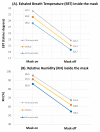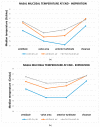Community Use of Face Masks against the Spread of COVID-19
- PMID: 33808861
- PMCID: PMC8003592
- DOI: 10.3390/ijerph18063214
Community Use of Face Masks against the Spread of COVID-19
Abstract
The role of face masks to prevent and control COVID-19 is critical, especially since asymptomatic or pre-symptomatic infected individuals can shed high loads of SARS-CoV-2 in the surrounding environment. In addition to being a two-way barrier to protect against virions droplets both in terms of "source control" (for the benefits of the community) and "physical protection" (for wearer), face masks also allow maintaining physiological temperatures and humidity of the nasal cavity and mouth, independently from the external environmental conditions. Beyond compromising the viral transmission speed, exposure to cold environments could have a detrimental effect on the host's susceptibility to SARS-CoV-2. The innate human immune system becomes in fact weaker with cooler nose temperatures and thus more vulnerable to viral replication. Furthermore, there is evidence that warm, humid climates are associated with reduced spread of SARS-CoV-2, while cold dry conditions favor its stability and transmissibility. In the early stage of a viral infection, a physiological body temperature in the upper airways supports the innate immune system, endorsing the muco-ciliary clearance, inhibiting, or deactivating any first settlement of viruses. Face masks are therefore strongly recommended also outdoors, especially under cold weather conditions, not only as a physical barrier against the transmission of SARS-CoV-2, but also to prevent the rapid cooling of the nasal mucosa and the inhibition of the human innate defense of the upper airways.
Keywords: COVID-19; SARS-CoV-2; face masks; health protection; nasal cavity; transmissibility.
Conflict of interest statement
The authors declare no conflict of interest.
Figures



Similar articles
-
Perspective of the Relationship between the Susceptibility to Initial SARS-CoV-2 Infectivity and Optimal Nasal Conditioning of Inhaled Air.Int J Mol Sci. 2021 Jul 24;22(15):7919. doi: 10.3390/ijms22157919. Int J Mol Sci. 2021. PMID: 34360686 Free PMC article. Review.
-
Heterogeneity in transmissibility and shedding SARS-CoV-2 via droplets and aerosols.Elife. 2021 Apr 16;10:e65774. doi: 10.7554/eLife.65774. Elife. 2021. PMID: 33861198 Free PMC article.
-
Physical interventions to interrupt or reduce the spread of respiratory viruses.Cochrane Database Syst Rev. 2020 Nov 20;11(11):CD006207. doi: 10.1002/14651858.CD006207.pub5. Cochrane Database Syst Rev. 2020. Update in: Cochrane Database Syst Rev. 2023 Jan 30;1:CD006207. doi: 10.1002/14651858.CD006207.pub6. PMID: 33215698 Free PMC article. Updated.
-
Effectiveness of Face Masks in Preventing Airborne Transmission of SARS-CoV-2.mSphere. 2020 Oct 21;5(5):e00637-20. doi: 10.1128/mSphere.00637-20. mSphere. 2020. PMID: 33087517 Free PMC article.
-
"Therapeutic" facemasks.Med Hypotheses. 2020 Oct;143:109855. doi: 10.1016/j.mehy.2020.109855. Epub 2020 May 19. Med Hypotheses. 2020. PMID: 32460210 Free PMC article.
Cited by
-
Global Experiences of Community Responses to COVID-19: A Systematic Literature Review.Front Public Health. 2022 Jul 19;10:907732. doi: 10.3389/fpubh.2022.907732. eCollection 2022. Front Public Health. 2022. PMID: 35928483 Free PMC article.
-
Cross-sectional study: mindset towards Coronavirus in developing countries and lessons learned: the case of Sudan.Ann Med Surg (Lond). 2024 May 1;86(7):3900-3908. doi: 10.1097/MS9.0000000000002056. eCollection 2024 Jul. Ann Med Surg (Lond). 2024. PMID: 38989223 Free PMC article.
-
The impact of UK social distancing guidance on the ability to access support and the health and wellbeing of disabled people during the COVID-19 pandemic: a qualitative exploration.BMC Public Health. 2024 Jun 30;24(1):1749. doi: 10.1186/s12889-024-19285-0. BMC Public Health. 2024. PMID: 38951865 Free PMC article.
-
The Impact of COVID-19 on Individuals with Hearing and Visual Disabilities during the First Pandemic Wave in Italy.Int J Environ Res Public Health. 2021 Sep 28;18(19):10208. doi: 10.3390/ijerph181910208. Int J Environ Res Public Health. 2021. PMID: 34639515 Free PMC article.
-
SARS-CoV-2 Infection in Health Care Workers of Trieste (North-Eastern Italy), 1 October 2020-7 February 2022: Occupational Risk and the Impact of the Omicron Variant.Viruses. 2022 Jul 28;14(8):1663. doi: 10.3390/v14081663. Viruses. 2022. PMID: 36016284 Free PMC article.
References
MeSH terms
Grants and funding
LinkOut - more resources
Full Text Sources
Other Literature Sources
Medical
Miscellaneous

